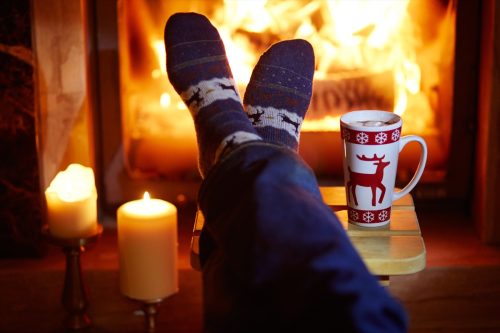5 Types of Socks You Should Own as You Get Older, Podiatrists Say

It’s no secret that your body changes a little bit with every passing year—and with so many age-related adjustments, it’s easy to overlook all of the ways that aging can affect foot health in particular. However, podiatrists say that taking care of your feet becomes especially important over the age of 50, by which point the average American has walked over 75,000 miles, according to UCLA Health. All of that activity—though great for your broader wellness—can take a toll on your muscles, ligaments, bones, and tendons. The good news? Experts say that choosing the right socks (and of course shoes) can help you avoid strain and injury. Read on to learn which five types of socks you should definitely own as you get older.
RELATED: 8 Retail Brands That Sell the Best Quality Walking Shoes.
1
Cushioned athletic socks

Choosing the right socks is that much more important when you plan to work out since physical activity can cause blisters, muscle strain, shock to the joints, and more.
Tony Hu, DPodM, a chiropodist for Family Wellness Foot Care in Ontario, Canada, says that as you get older, you should have cushioned athletic socks on hand for just such an occasion.
“These offer extra padding and shock absorption, reducing impact during workouts and providing support for aging joints, ultimately minimizing strain and potential injuries,” Hu explains.
He adds that looking for a moisture-wicking brand will also help prevent fungal infections and minimize the risk of blisters.
RELATED: 5 Essential Reasons You Should Start Wearing “House Sneakers,” Podiatrists Say.
2
Arch support socks

Ideally, any pair of socks you wear should have built-in arch support, Hu says.
“Arch support socks help to keep the arches of the feet in alignment, which can help to reduce pain and improve balance,” the podiatry expert explains. “They are especially beneficial for people who have flat feet or who suffer from plantar fasciitis,” a type of inflammation that causes heel pain.
However, he notes that all too often, people make the mistake of sacrificing comfort for style when they wear dressier shoes. Hu says that rather than skipping socks entirely when you wear flats or low-cut shoes, you should opt for no-show socks with added support.
3
Diabetic socks

If you’re over 50 and have certain health conditions, your doctor may recommend particular footwear. For instance, Hu says that individuals with diabetes should look for specialized socks that are made to help reduce their risk of complications in the legs and feet.
“Designed with seamless toe closures and non-binding tops, diabetic socks prevent friction and pressure points, promoting healthy blood flow and minimizing the risk of ulcers or infections,” explains Hu.
Chirag Patel, MD, a podiatrist for New Horizons Foot and Ankle Associates in Lexington, Kentucky, says that the color you choose also makes a difference in this case. In particular, he recommends wearing white socks, which can help alert you to foot problems that you may not notice due to reduced sensitivity in the feet.
“Diabetics tend to lose sensation on the bottom part of their feet, resulting in higher risk of ulcers and wounds,” Patel explains. “If a non-diabetic were to have a pebble in their shoe, they would immediately remove it due to the discomfort. A diabetic with loss of protective sensation would not feel the pebble and continue to wear the shoe. Of course, this could result in compromise of the skin on the bottom of the foot such as tenderness, a cut, or worse—an ulcer.”
By wearing white socks, you’ll be more likely to notice other symptoms of a skin problem, such as drainage or bleeding.
RELATED: 5 Ways to Make Your Shoes More Comfortable If You’re Over 60, Podiatrists Say.
4
Compression socks

While most adults will not need to wear them on a daily basis, Hu says that all people over 50 should own a pair or two of compression socks. These apply pressure to the lower legs, which can help blood flow more freely.
“Compression socks help to improve circulation, which can help to reduce swelling and pain in the feet and legs,” says Hu. “They are especially beneficial for people who are on their feet a lot, such as those who work long hours or who travel frequently.”
Patel adds that all older adults stand to benefit from wearing compression socks “regardless of an existing ailment,” since they can help to prevent problems in the vascular and lymphatic system.
“A podiatrist can provide measurements for the ‘right’ level of compression, as it does vary in effectiveness from patient to patient. However, there are some over-the-counter socks that can provide initial levels of compression to start,” he tells Best Life.
For more wellness content sent directly to your inbox, sign up for our daily newsletter.
5
Warm thermal socks

Older adults often feel colder than their younger counterparts‒especially in their hands and feet. That’s why Hu recommends investing in a few pairs of warm thermal socks for the winter.
“Essential for colder weather, thermal socks keep feet warm, improving circulation and reducing the risk of cold-related issues like frostbite or Raynaud’s disease,” he says.